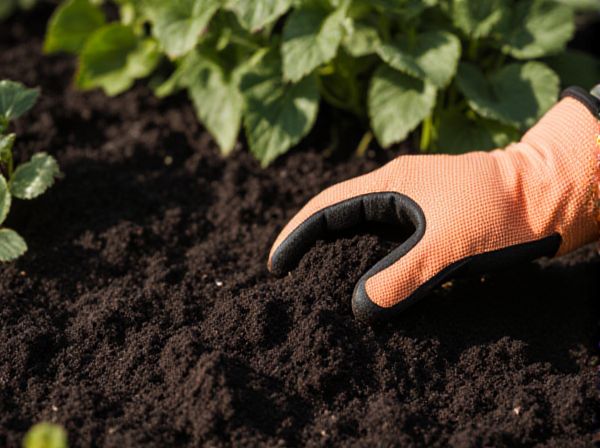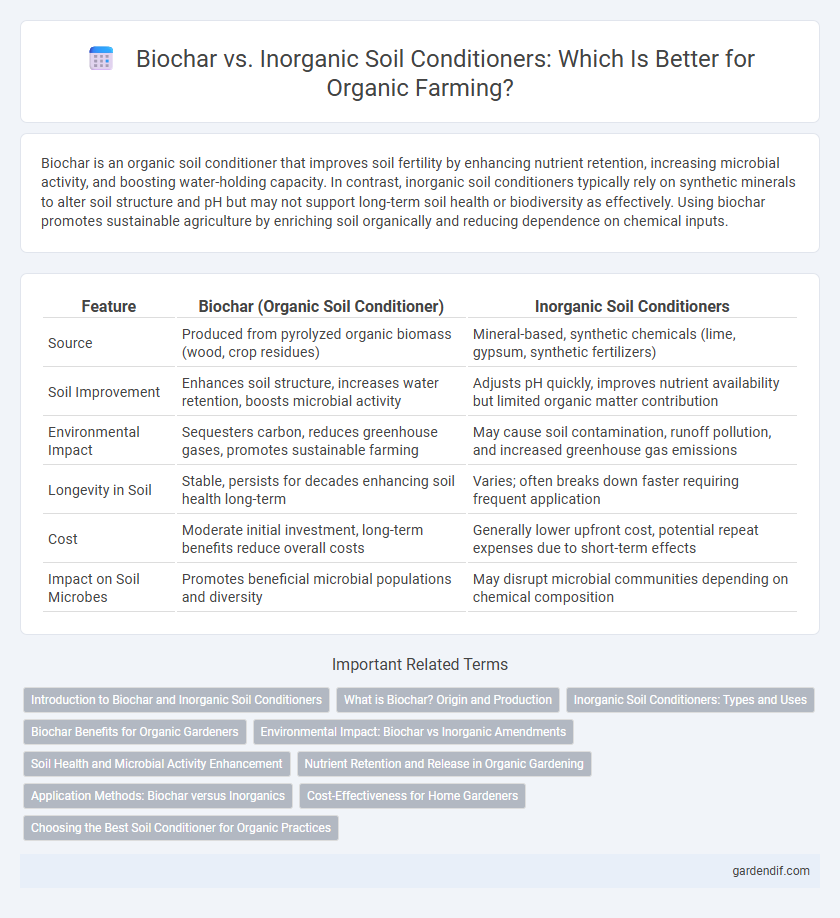
Biochar vs Inorganic soil conditioners Illustration
Biochar is an organic soil conditioner that improves soil fertility by enhancing nutrient retention, increasing microbial activity, and boosting water-holding capacity. In contrast, inorganic soil conditioners typically rely on synthetic minerals to alter soil structure and pH but may not support long-term soil health or biodiversity as effectively. Using biochar promotes sustainable agriculture by enriching soil organically and reducing dependence on chemical inputs.
Table of Comparison
| Feature | Biochar (Organic Soil Conditioner) | Inorganic Soil Conditioners |
|---|---|---|
| Source | Produced from pyrolyzed organic biomass (wood, crop residues) | Mineral-based, synthetic chemicals (lime, gypsum, synthetic fertilizers) |
| Soil Improvement | Enhances soil structure, increases water retention, boosts microbial activity | Adjusts pH quickly, improves nutrient availability but limited organic matter contribution |
| Environmental Impact | Sequesters carbon, reduces greenhouse gases, promotes sustainable farming | May cause soil contamination, runoff pollution, and increased greenhouse gas emissions |
| Longevity in Soil | Stable, persists for decades enhancing soil health long-term | Varies; often breaks down faster requiring frequent application |
| Cost | Moderate initial investment, long-term benefits reduce overall costs | Generally lower upfront cost, potential repeat expenses due to short-term effects |
| Impact on Soil Microbes | Promotes beneficial microbial populations and diversity | May disrupt microbial communities depending on chemical composition |
Introduction to Biochar and Inorganic Soil Conditioners
Biochar, a carbon-rich organic material produced through pyrolysis of biomass, enhances soil fertility by improving water retention, nutrient availability, and microbial activity. In contrast, inorganic soil conditioners such as gypsum, lime, and synthetic polymers primarily alter soil pH, structure, and nutrient balance through mineral-based amendments. Understanding the biochemical and physical impacts of biochar versus inorganic conditioners is essential for optimizing sustainable soil management and crop productivity.
What is Biochar? Origin and Production
Biochar is a porous, carbon-rich material produced through the pyrolysis of organic biomass such as wood, crop residues, or manure in a low-oxygen environment. Its origin traces back to ancient Amazonian practices, where Terra Preta soils were enriched with charcoal to enhance fertility. Biochar improves soil structure, water retention, and microbial activity, differentiating it from inorganic soil conditioners that rely on synthetic minerals.
Inorganic Soil Conditioners: Types and Uses
Inorganic soil conditioners such as gypsum, lime, and synthetic polymers improve soil structure by enhancing aeration, water retention, and nutrient availability. Gypsum is commonly used to reduce soil salinity and improve clay soil permeability, while lime adjusts soil pH to optimize nutrient uptake. Synthetic polymers increase soil moisture retention and prevent erosion, making them essential for maintaining soil health in various agricultural applications.
Biochar Benefits for Organic Gardeners
Biochar enhances soil structure, increases water retention, and boosts microbial activity, making it ideal for organic gardeners seeking sustainable soil improvement. It sequesters carbon, improving soil fertility naturally without synthetic additives commonly found in inorganic soil conditioners. The porous nature of biochar supports beneficial soil microbes, promoting healthier plant growth and reducing the need for chemical fertilizers.
Environmental Impact: Biochar vs Inorganic Amendments
Biochar enhances soil carbon sequestration by storing stable carbon for centuries, significantly reducing greenhouse gas emissions compared to inorganic soil conditioners. Inorganic amendments often lead to soil acidification and heavy metal accumulation, causing long-term environmental degradation and reduced soil biodiversity. Biochar's porous structure improves water retention and nutrient cycling, promoting healthier ecosystems while inorganic additives may disrupt soil microbial communities and groundwater quality.
Soil Health and Microbial Activity Enhancement
Biochar significantly improves soil health by enhancing nutrient retention, increasing soil aeration, and promoting water-holding capacity, which creates an optimal environment for microbial activity. Unlike inorganic soil conditioners, biochar supports the proliferation of beneficial microbes such as nitrogen-fixing bacteria and mycorrhizal fungi that play a crucial role in nutrient cycling and plant growth. The porous structure of biochar provides habitat for microorganisms, resulting in enhanced soil biological diversity and long-term soil fertility.
Nutrient Retention and Release in Organic Gardening
Biochar enhances nutrient retention by improving soil porosity and cation exchange capacity, allowing organic gardening soils to hold and slowly release essential nutrients like nitrogen, phosphorus, and potassium. In contrast, inorganic soil conditioners often supply immediate nutrient availability but lack the ability to sustain nutrient release over time, leading to potential leaching and environmental runoff. Choosing biochar supports long-term soil fertility and healthier plant growth through balanced nutrient management in organic gardening systems.
Application Methods: Biochar versus Inorganics
Biochar is typically applied by incorporating it into the soil through tilling or mixing, which enhances soil structure and promotes microbial activity over time. Inorganic soil conditioners are often used as surface applications or dissolved in irrigation water, providing immediate but short-term improvements in soil nutrient availability and pH balance. The slow-release and carbon-rich nature of biochar contrasts with the quicker, more targeted effects of inorganic conditioners, influencing long-term soil health and fertility.
Cost-Effectiveness for Home Gardeners
Biochar offers a cost-effective solution for home gardeners by improving soil fertility and water retention with a one-time application, reducing the need for frequent treatments compared to inorganic soil conditioners. Inorganic conditioners often require regular replenishment, increasing long-term expenses without contributing to soil carbon sequestration. The upfront investment in biochar can lead to significant savings and environmental benefits in small-scale organic gardening.
Choosing the Best Soil Conditioner for Organic Practices
Biochar enhances soil fertility by improving water retention, microbial activity, and carbon sequestration, making it ideal for organic farming. Inorganic soil conditioners often rely on synthetic chemicals that can disrupt soil ecology and reduce long-term soil health. Selecting biochar supports sustainable organic practices by promoting natural soil regeneration and minimizing environmental impact.
Biochar vs Inorganic soil conditioners Infographic

 gardendif.com
gardendif.com